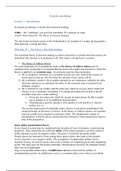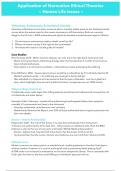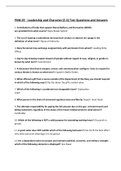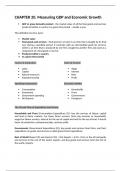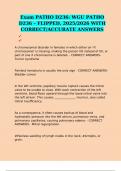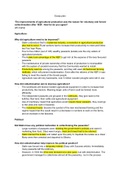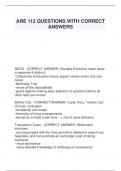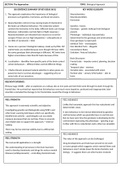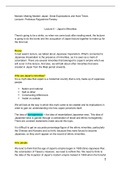Case 4 behavioural problems?
Basset: SPECT during sleep walking
- Sleepwalking is a dissociation between body sleep and mind sleep. We report single
photon emission computed tomography (SPECT) in a man with a history of
sleepwalking. Our findings suggest that this dissociation arises from activation of
thalamocingulate pathways and persisting deactivation of other thalamocortical
arousal systems.
- Sleepwalking refers to various complex motor behaviours, including walking, that are
initiated during deep (stages 3–4) non-rapid-eye-movement (NREM) sleep (slow-
wave sleep). The association of abrupt motor activity with diffuse, rhythmic, high-
voltage bursts of delta electroencephalographic (EEG) activity indicates a dissociation
between mental and motor arousal.
- An increase of over 25% in regional cerebral blood flow during sleepwalking was
related to the reference stage of slow-wave sleep, and was confined to the posterior
cingulate cortex and to the anterior cerebellum. Compared with awake normal
volunteers a decrease in regional cerebral blood flow was found during sleepwalking
in the frontoparietal associative cortices.
- The decreased regional cerebral blood flow in the frontoparietal cortices found during
sleepwalking is consistent with the view of sleepwalking as a dissociated state
consisting of motor arousal and persisting mind sleep. This deactivation of prefrontal
cortices during normal sleep and sleepwalking also explains the lack of self-related
awareness, insight, and recall that characterise both conditions. On the other hand, the
activation of the cingulate cortex and the absence of a deactivation of the thalamus
found in our patient contrasts with the profound deactivation of these brain structures
during normal slow-wave sleep. Hence, sleepwalking seems to arise from the selective
activation of thalamocingulate circuits and the persisting inhibition of other
thalamocortical arousal systems. The activation of the posterior cingulate cortex in our
patient may, therefore, relate to the long mental confusion but only transient motor
activation of the observed sleepwalking episode. More generally, it can be postulated
that variations in the motor, vegetative, and emotional manifestations of sleepwalking
and sleep terror are related to different activation patterns of the cingulate cortex.
Zadra: Somnambulism (sleepwalking): clinical aspects and pathophysiological
hypotheses
- episodes typically take place during the first third of the night when slow-wave sleep
is predominant, although episodes can also occur in N2 sleep. Somnambulism is
therefore classified as an NREM parasomnia, the category that also includes
confusional arousals and sleep terrors.
- a series of complex behaviours that are usually initiated during arousals from slow-
wave sleep and culminate in walking around with an altered state of consciousness and
impaired judgment. Episodes can last from a few seconds to more than 30 min. Most
behavioural episodes are characterised by misperception and unresponsiveness to
external stimuli, mental confusion, perceived threat, and variable retrograde amnesia.
- Somnambulism is more common in childhood than in adulthood. 3% in toddlers (age
2,5–4 years), and steadily increases to about 11% at 7 and 8
years and 13,5% at 10 years, before falling to 12,7% at 12
years. 2–4% in adulthood
- Comorbidity: 25% of adult sleepwalkers self-report
concurrent anxiety or mood disorders. In early childhood,
the occurrence of somnambulism might be associated with
1
, separation anxiety, and anxiety or stress might increase the occurrence of episodes in
both children and adults.
- Roughly 80% of sleepwalkers have at least one affected family member, and the
prevalence of somnambulism is higher in children whose parents have a history of
somnambulism than in those whose parents have no such history.
- Misconceptions: sleepwalking has no daytime consequences (excessive daytime
somnolence might be an important characteristic of somnambulism), that it is
characterised by amnesia for the episode (many patients can and do recall at least
portions of episodes upon awakening, and thus suggest that complete amnesia of the
event is not standard for adult sleepwalkers. In children, somnambulism might be
more likely to consist of automatic behaviours and complete amnesia might be more
common, possibly because of higher arousal thresholds), and that it is an automatic
behaviour arising in the absence of dream-like mental activity (sleepwalking might be
the acting out of dreamlike mentations.).
- Diagnosis and management: Challenging cases might warrant thorough
polysomnographic assessments with an extended EEG montage and continuous audio
visual recording. Disorders that are known to increase pressure for deep sleep or
arousals during sleep, or to induce confusional states should be considered in clinical
management of somnambulism. clinicians should emphasise the importance of getting
sufficient sleep and avoidance of irregular sleep schedules to patients with
somnambulism. Similarly, most causes of increased arousals from sleep and the
presence of concomitant sleep disorders capable of causing recurrent microarousals
are precipitating factors. precautions should be taken to ensure a safe sleep
environment.
- Treatment: Hypnosis (including self-hypnosis) is effective in both children and adults
with chronic somnambulism. In children, the preferred treatment is anticipatory or
scheduled awakening—a behavioural technique whereby parents awaken their child
nightly about 15 min before the typical time of occurrence of an episode for about a
month. Drugs should be prescribed only when behaviours are potentially hazardous or
extremely disruptive to bed partners or other household members. Benzodiazepines,
particularly clonazepam and diazepam, have been used. These drugs decrease arousals
and anxiety and suppress slow-wave sleep, but do not always adequately control
sleepwalking.
- overall decrease in slow-wave activity during the first sleep cycle, and a different time
course of slow-wave activity decay throughout the night. These results suggest that
sleepwalkers’ frequent awakenings from deep sleep interfere with the normal build-up
of slow-wave activity, especially during the first two sleep cycles when most
awakenings from deep sleep occur in sleepwalkers. sleepwalkers have significantly
more hypersynchronous delta waves during NREM sleep than do controls. sleep
deprivation actually results in more awakenings from slow-wave sleep during
recovery sleep. sleep deprivation increases the number of somnambulistic events
recorded in the laboratory by a factor of 2,5 to 5. Somnambulistic episodes are not
only more complex but also often more agitated, with forced arousals out of recovery
slow-wave sleep after sleep deprivation.
- sleepwalkers are caught between NREM sleep and full EEG arousal and are thus
neither fully awake nor fully asleep during episodes. Experimentally triggered arousals
by auditory stimulation during slow-wave sleep induce episodes in sleepwalkers
during normal sleep and even more frequently during recovery sleep
- sleep depth does not occur simultaneously throughout the brain and that the
frequency-specific topographical differences are distributed along the anteroposterior
2
Basset: SPECT during sleep walking
- Sleepwalking is a dissociation between body sleep and mind sleep. We report single
photon emission computed tomography (SPECT) in a man with a history of
sleepwalking. Our findings suggest that this dissociation arises from activation of
thalamocingulate pathways and persisting deactivation of other thalamocortical
arousal systems.
- Sleepwalking refers to various complex motor behaviours, including walking, that are
initiated during deep (stages 3–4) non-rapid-eye-movement (NREM) sleep (slow-
wave sleep). The association of abrupt motor activity with diffuse, rhythmic, high-
voltage bursts of delta electroencephalographic (EEG) activity indicates a dissociation
between mental and motor arousal.
- An increase of over 25% in regional cerebral blood flow during sleepwalking was
related to the reference stage of slow-wave sleep, and was confined to the posterior
cingulate cortex and to the anterior cerebellum. Compared with awake normal
volunteers a decrease in regional cerebral blood flow was found during sleepwalking
in the frontoparietal associative cortices.
- The decreased regional cerebral blood flow in the frontoparietal cortices found during
sleepwalking is consistent with the view of sleepwalking as a dissociated state
consisting of motor arousal and persisting mind sleep. This deactivation of prefrontal
cortices during normal sleep and sleepwalking also explains the lack of self-related
awareness, insight, and recall that characterise both conditions. On the other hand, the
activation of the cingulate cortex and the absence of a deactivation of the thalamus
found in our patient contrasts with the profound deactivation of these brain structures
during normal slow-wave sleep. Hence, sleepwalking seems to arise from the selective
activation of thalamocingulate circuits and the persisting inhibition of other
thalamocortical arousal systems. The activation of the posterior cingulate cortex in our
patient may, therefore, relate to the long mental confusion but only transient motor
activation of the observed sleepwalking episode. More generally, it can be postulated
that variations in the motor, vegetative, and emotional manifestations of sleepwalking
and sleep terror are related to different activation patterns of the cingulate cortex.
Zadra: Somnambulism (sleepwalking): clinical aspects and pathophysiological
hypotheses
- episodes typically take place during the first third of the night when slow-wave sleep
is predominant, although episodes can also occur in N2 sleep. Somnambulism is
therefore classified as an NREM parasomnia, the category that also includes
confusional arousals and sleep terrors.
- a series of complex behaviours that are usually initiated during arousals from slow-
wave sleep and culminate in walking around with an altered state of consciousness and
impaired judgment. Episodes can last from a few seconds to more than 30 min. Most
behavioural episodes are characterised by misperception and unresponsiveness to
external stimuli, mental confusion, perceived threat, and variable retrograde amnesia.
- Somnambulism is more common in childhood than in adulthood. 3% in toddlers (age
2,5–4 years), and steadily increases to about 11% at 7 and 8
years and 13,5% at 10 years, before falling to 12,7% at 12
years. 2–4% in adulthood
- Comorbidity: 25% of adult sleepwalkers self-report
concurrent anxiety or mood disorders. In early childhood,
the occurrence of somnambulism might be associated with
1
, separation anxiety, and anxiety or stress might increase the occurrence of episodes in
both children and adults.
- Roughly 80% of sleepwalkers have at least one affected family member, and the
prevalence of somnambulism is higher in children whose parents have a history of
somnambulism than in those whose parents have no such history.
- Misconceptions: sleepwalking has no daytime consequences (excessive daytime
somnolence might be an important characteristic of somnambulism), that it is
characterised by amnesia for the episode (many patients can and do recall at least
portions of episodes upon awakening, and thus suggest that complete amnesia of the
event is not standard for adult sleepwalkers. In children, somnambulism might be
more likely to consist of automatic behaviours and complete amnesia might be more
common, possibly because of higher arousal thresholds), and that it is an automatic
behaviour arising in the absence of dream-like mental activity (sleepwalking might be
the acting out of dreamlike mentations.).
- Diagnosis and management: Challenging cases might warrant thorough
polysomnographic assessments with an extended EEG montage and continuous audio
visual recording. Disorders that are known to increase pressure for deep sleep or
arousals during sleep, or to induce confusional states should be considered in clinical
management of somnambulism. clinicians should emphasise the importance of getting
sufficient sleep and avoidance of irregular sleep schedules to patients with
somnambulism. Similarly, most causes of increased arousals from sleep and the
presence of concomitant sleep disorders capable of causing recurrent microarousals
are precipitating factors. precautions should be taken to ensure a safe sleep
environment.
- Treatment: Hypnosis (including self-hypnosis) is effective in both children and adults
with chronic somnambulism. In children, the preferred treatment is anticipatory or
scheduled awakening—a behavioural technique whereby parents awaken their child
nightly about 15 min before the typical time of occurrence of an episode for about a
month. Drugs should be prescribed only when behaviours are potentially hazardous or
extremely disruptive to bed partners or other household members. Benzodiazepines,
particularly clonazepam and diazepam, have been used. These drugs decrease arousals
and anxiety and suppress slow-wave sleep, but do not always adequately control
sleepwalking.
- overall decrease in slow-wave activity during the first sleep cycle, and a different time
course of slow-wave activity decay throughout the night. These results suggest that
sleepwalkers’ frequent awakenings from deep sleep interfere with the normal build-up
of slow-wave activity, especially during the first two sleep cycles when most
awakenings from deep sleep occur in sleepwalkers. sleepwalkers have significantly
more hypersynchronous delta waves during NREM sleep than do controls. sleep
deprivation actually results in more awakenings from slow-wave sleep during
recovery sleep. sleep deprivation increases the number of somnambulistic events
recorded in the laboratory by a factor of 2,5 to 5. Somnambulistic episodes are not
only more complex but also often more agitated, with forced arousals out of recovery
slow-wave sleep after sleep deprivation.
- sleepwalkers are caught between NREM sleep and full EEG arousal and are thus
neither fully awake nor fully asleep during episodes. Experimentally triggered arousals
by auditory stimulation during slow-wave sleep induce episodes in sleepwalkers
during normal sleep and even more frequently during recovery sleep
- sleep depth does not occur simultaneously throughout the brain and that the
frequency-specific topographical differences are distributed along the anteroposterior
2


